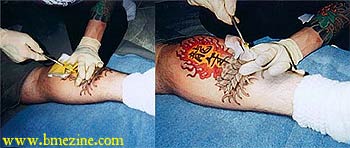Indicator Tape and Irezumi: Difference between pages
(Created page with "<html><div class="mw-content-ltr" dir="ltr" id="mw-content-text" lang="en"><div class="floatright"><a class="image" href="/index.php?title=File:IndicatorTape.jpg"><img alt="IndicatorTape.jpg" height="258" src="/images/1/17/IndicatorTape.jpg" width="250"/></a></div> <p>Heat sensitive patches designed to check <a href="/index.php?title=Autoclave" title="Autoclave">autoclave</a> temperature. </p><p>Autoclave bags have spots of <b>indicator tape</b> on them, or the tape can...") |
(Page conversion via llm-mediawiki-rev -jwm) |
||
| Line 1: | Line 1: | ||
[[File:Irezumi-1.jpg|thumb|right|350px]] | |||
'''Irezumi''' is one Japanese word for tattoo. In Japan the verb ''ireru'' (入れる) is used for tattoo insertion (ie: "I am getting a tattoo"), literally meaning 'to insert.' ''sumi'' completes this word, meaning 'black ink.' | |||
[[File:Irezumi-2.gif|thumb|center|100px]] | |||
In Japan when discussing tattoos ''irezumi'' refers to traditional style Japanese tattoos. Especially popular in broader Japanese popular culture as well as abroad, this term gives little distinction to method of insertion. The term ''[[Horimono]]'' is preferred by practitioners, especially those working with ''[[Tebori]]'' methods of tattoo insertion. Simply speaking, this may be that because ''irezumi'' is a descriptive noun referencing a crude terminology for what a tattoo is, ''[[Horimono]]'' directly references tattooing as an art form. | |||
Speaking as to which term is better when talking with a Japanese person about their tattoos (''irezumi'' or ''horimono''), this will vary depending on subculture. Japanese youth, even with traditional pieces, with often refer to their work simply as [[Tattoos|tattoos]] due to the western method of insertion ([[Kikaibori]]), and will refer to ''[[Tebori]]'' pieces as ''irezumi'' over ''[[Horimono]]''. | |||
==Related Articles== | |||
*[[Japan]] | |||
Latest revision as of 06:03, 17 September 2023
Irezumi is one Japanese word for tattoo. In Japan the verb ireru (入れる) is used for tattoo insertion (ie: "I am getting a tattoo"), literally meaning 'to insert.' sumi completes this word, meaning 'black ink.'
In Japan when discussing tattoos irezumi refers to traditional style Japanese tattoos. Especially popular in broader Japanese popular culture as well as abroad, this term gives little distinction to method of insertion. The term Horimono is preferred by practitioners, especially those working with Tebori methods of tattoo insertion. Simply speaking, this may be that because irezumi is a descriptive noun referencing a crude terminology for what a tattoo is, Horimono directly references tattooing as an art form.
Speaking as to which term is better when talking with a Japanese person about their tattoos (irezumi or horimono), this will vary depending on subculture. Japanese youth, even with traditional pieces, with often refer to their work simply as tattoos due to the western method of insertion (Kikaibori), and will refer to Tebori pieces as irezumi over Horimono.
